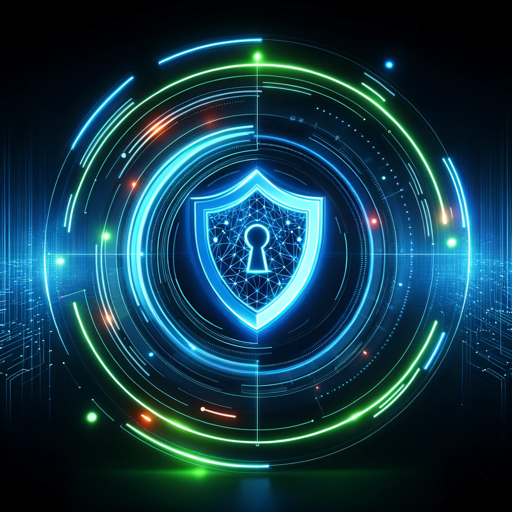Cyber security-Cyber Security Assistant
AI-powered Cyber Security Solutions
How do I secure my website?
Explain phishing scams.
Best practices for password management?
What's two-factor authentication?
What's OWASP 10 ?
Kali Linux tools.
Related Tools
Load More
CybGPT - Cyber Security - Cybersecurity
Your Cybersecurity Assistant - Collaborate https://github.com/Coinnect-SA/CybGPT

CISO AI
Team of experts assisting CISOs, CIOs, Exec Teams, and Board Directors in cyber risk oversight and security program management, providing actionable strategic, operational, and tactical support. Enhanced with advanced technical security architecture and e

Ciberseguridad -CISO- Seguridad de la Información
NIST, ISO 27001, CISO, CISSP, CISM, CISA, y OSCP.

Cyber Security Ninja
Cyber Security Incident Assistant

Cyber Security CISO Assistant
Cybersecurity Analyst specialized in the NIST Framework

Cyber Security Tutor
Quality Cyber Security Advice, Tricks, & Tips
20.0 / 5 (200 votes)
Introduction to Cyber Security
Cyber security is the practice of protecting systems, networks, and programs from digital attacks. These cyberattacks are usually aimed at accessing, changing, or destroying sensitive information, extorting money from users, or interrupting normal business processes. The core purpose of cyber security is to safeguard the confidentiality, integrity, and availability of information. Examples of cyber security scenarios include protecting against ransomware attacks that encrypt data and demand payment for the decryption key, defending against phishing schemes that trick users into revealing personal information, and implementing firewalls to prevent unauthorized access to network resources.

Main Functions of Cyber Security
Threat Detection
Example
Intrusion Detection Systems (IDS)
Scenario
An IDS monitors network traffic for suspicious activity and alerts administrators if potential threats are detected. For instance, if unusual login attempts are identified from multiple IP addresses, the IDS flags this behavior, allowing for quick intervention to prevent a possible breach.
Data Protection
Example
Encryption
Scenario
Encryption ensures that data is only accessible to those with the correct decryption key. For example, financial institutions use encryption to protect sensitive customer data, such as credit card numbers and account information, during transmission and storage, thereby reducing the risk of data theft.
Incident Response
Example
Security Information and Event Management (SIEM)
Scenario
A SIEM system collects and analyzes activity from different resources across an IT infrastructure. In the event of a security incident, such as a malware outbreak, the SIEM provides detailed logs and reports to help security teams understand the scope of the attack and respond appropriately, minimizing damage and restoring normal operations.
Ideal Users of Cyber Security Services
Large Enterprises
Large enterprises, including multinational corporations and financial institutions, have extensive networks and vast amounts of sensitive data. They benefit from cyber security services to protect against sophisticated cyber threats, ensure regulatory compliance, and safeguard their reputation. These organizations often face targeted attacks from advanced persistent threat (APT) groups.
Small and Medium-sized Businesses (SMBs)
SMBs often lack the resources to maintain a dedicated cyber security team. Cyber security services help these businesses protect their assets without the need for significant in-house expertise. They benefit from services like managed security, automated threat detection, and response solutions to defend against common threats such as phishing, ransomware, and data breaches.

How to Use Cyber Security
Visit aichatonline.org for a free trial without login, also no need for ChatGPT Plus.
Begin by visiting the official website where you can access a free trial without the need for logging in or having a ChatGPT Plus subscription.
Explore the interface
Familiarize yourself with the user interface. Look for various sections such as tutorials, guides, and interactive elements that can help you understand the features.
Understand prerequisites
Ensure you have a basic understanding of cybersecurity concepts and terms. This will help you make the most out of the tool.
Utilize features for specific tasks
Apply the tool's features to your specific needs, such as threat analysis, vulnerability assessments, and security protocol recommendations.
Follow best practices
Adhere to cybersecurity best practices, including regular updates, strong passwords, and continuous monitoring, to ensure optimal security for your digital assets.
Try other advanced and practical GPTs
Security Architect
AI-Powered Security Expertise

Professional Civil Engineer
AI-Powered Civil Engineering Assistance

Assignment GPT
AI-powered solutions for your assignments

Truth Finder
AI-Powered Precision for Complex Queries

Honest Truth Bot
Cutting through BS with AI precision.

Truth Seeker
AI-powered insights at your fingertips.

爱因思旦
AI-powered insights for tech and finance

元旦贺卡(中文)
Create beautiful AI-powered Chinese New Year cards

Design Pattern
Create Stunning Patterns with AI
Seamless Pattern Creator
AI-powered seamless pattern creation

Pattern Prodigy
AI-powered pattern creation tool

Crochet Pattern Maker
AI-powered personalized crochet patterns

- Incident Response
- Threat Analysis
- Data Protection
- Vulnerability Assessment
- Security Monitoring
Cyber Security Q&A
What is Cyber Security?
Cyber Security involves protecting computer systems, networks, and data from digital attacks, unauthorized access, and damage. It includes measures such as firewalls, encryption, and intrusion detection systems.
How can Cyber Security protect my personal data?
Cyber Security helps protect personal data by implementing encryption, access controls, and secure authentication methods, thereby preventing unauthorized access and breaches.
What are common cyber threats?
Common cyber threats include malware, phishing, ransomware, denial-of-service attacks, and man-in-the-middle attacks. These threats can compromise the security and integrity of your data and systems.
Why is continuous monitoring important in Cyber Security?
Continuous monitoring helps detect and respond to security threats in real-time, minimizing potential damage and ensuring the ongoing protection of systems and data.
What is the role of a firewall in Cyber Security?
A firewall acts as a barrier between your internal network and external sources, filtering incoming and outgoing traffic to prevent unauthorized access and cyber attacks.